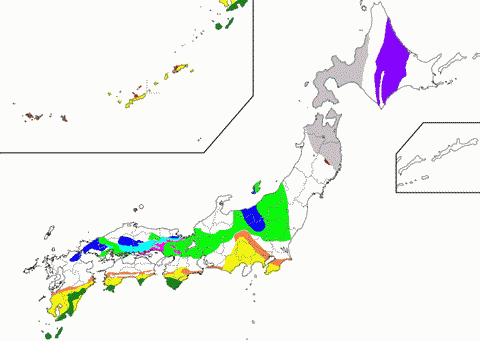Accretionary Complexes
Synonym
Accretinary Prism, Accreted Sediments, Accretionary Wedge
Overview
An island arc formed by subduction of oceanic plates under the east margin of the Eurasian continent.

The Philippine sea plate and the Pacific plate subduct under the Eurasian continent, and accretionary complexes were accreted at the eastern margin of the continental crusts. The eastern accretionary complex is the younger. These accretionary complexes were intruded by plutonic rocks, and deformed by the formation of a back-arc basin (the Japan Sea) and collision of intra-oceanic arcs (Izu-Bonin-Mariana Arc and Kuril Arc). This accretionary complex underlies unconformably sediments younger than Devonian and volcanic rocks younger than Neogene at the west of the volcanic front.
Brown: Nedamo Belt, Blue: Akiyoshi Belt, Light blue: Maizuru Belt, Red-purple: Ultra-Tamba Belt, Green: Tamba-Mino-Ashio Belt, Light brown: Chichibu Belt, Gray: North Kitakami Belt - Oshima Belt, Purple: Hidaka Belt, Yelllow: Northern Shimanto Belt, Dark green: Southern Shimanto Belt,
where Chichibu Belt and North Kitakami Belt - Oshima Belt are interpreted as a part of Tamba-Mino-Ashio Belt, and Hidaka belt is a part of Shimanto Belt.
Members
- Nedamo Belt (Carboniferous - Permian)
- Akiyoshi Belt (Late Permian)
- Maizuru Belt (Permina - Triassic)
- Ultra-Tamba Belt (Permian - Triassic)
- Tamba-Mino-Ashio Belt (Late Triassic - Jurassic)
- Chichibu Belt (Late Triassic - Jurassic, Tamba-Mino-Ashio Belt)
- North Kitakami Belt - Oshima Belt (Jurassic, Tamba-Mino-Ashio Belt)
- Hidaka Belt (Cretaceous, Shimanto belt)
- Northern Shimanto Belt (Late Cretaceous)
- Southern Shimanto Belt (Paleogene)